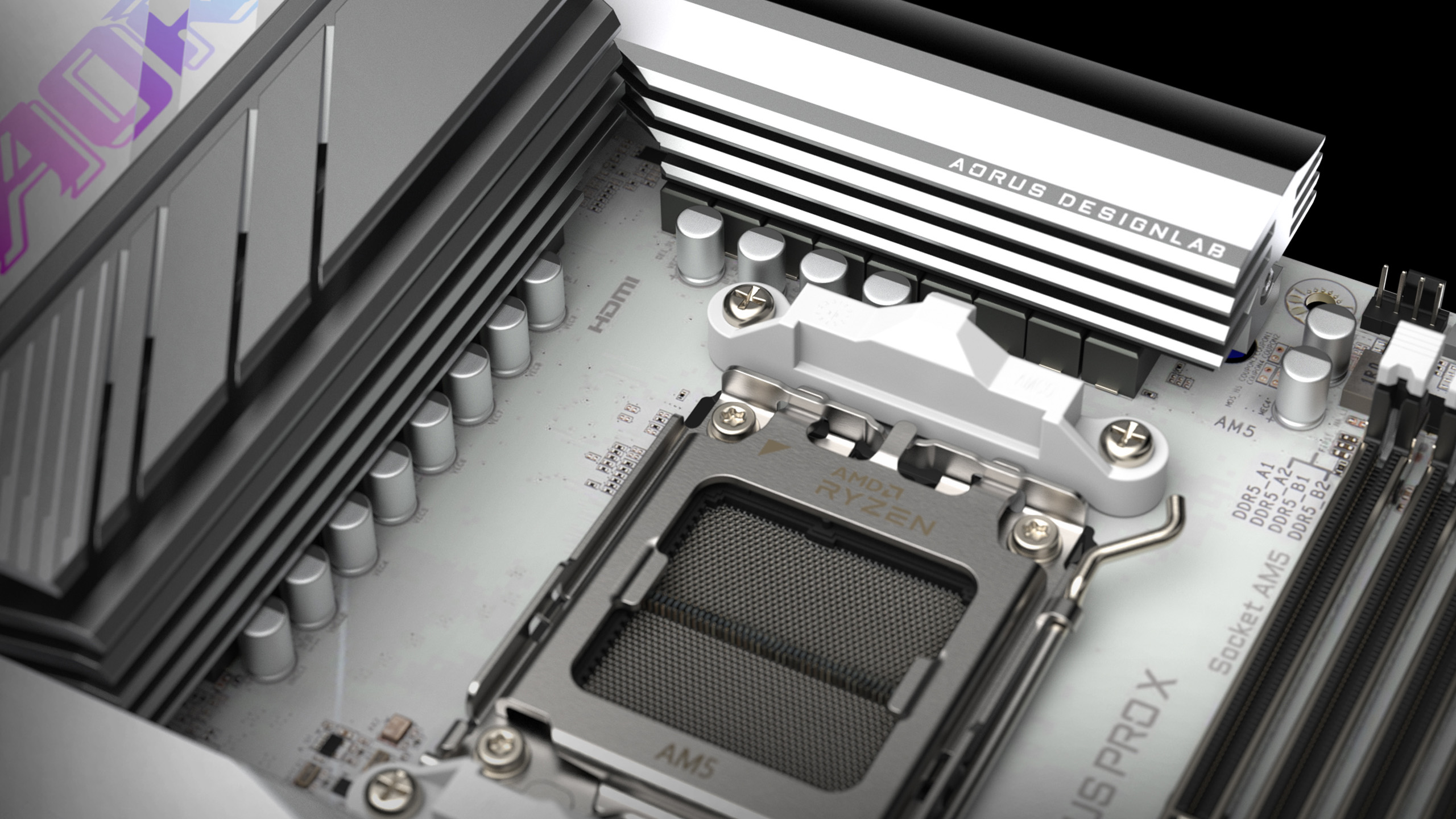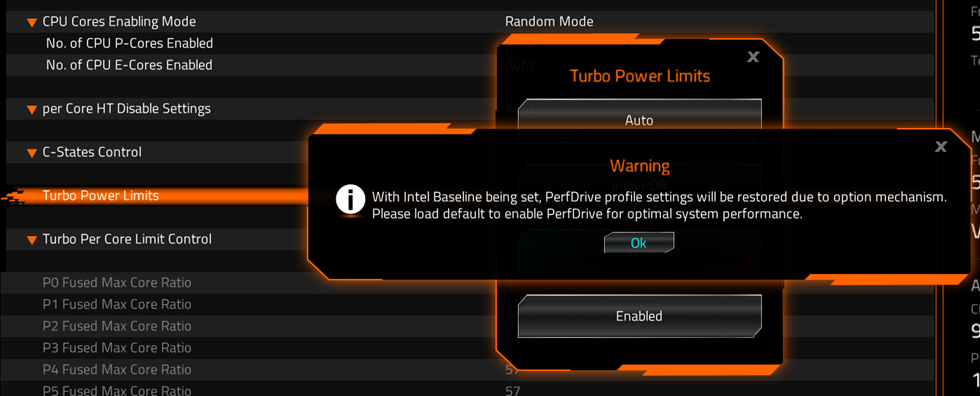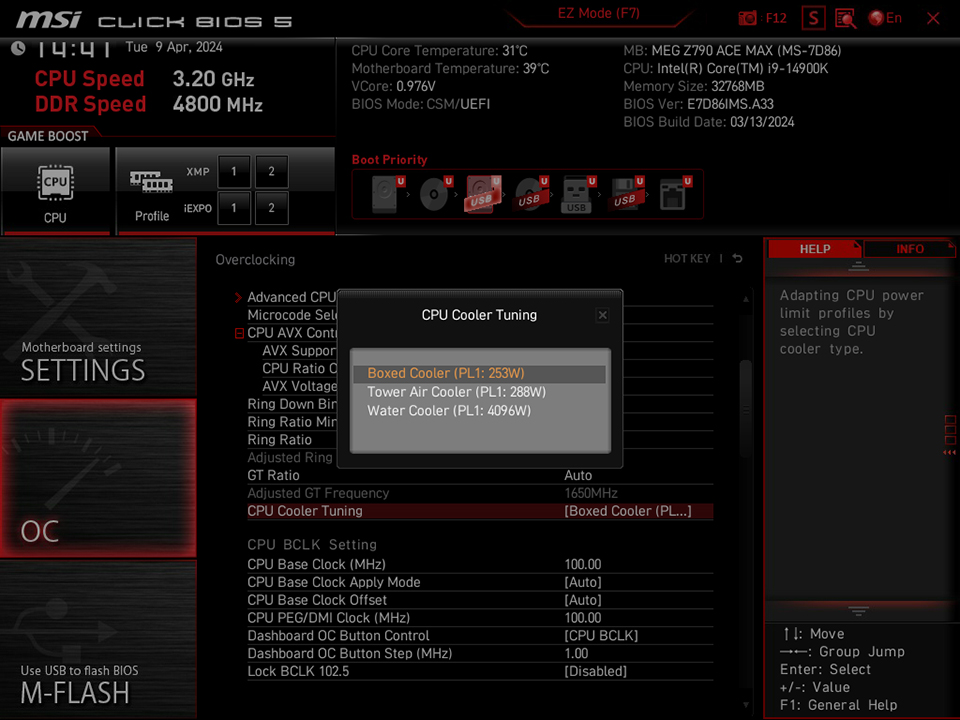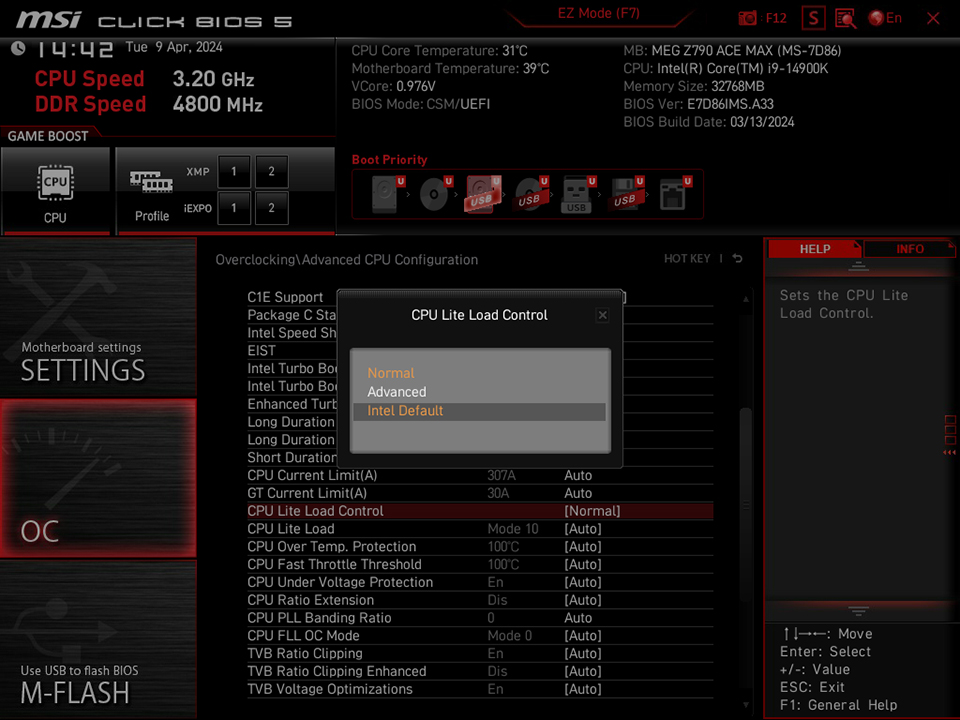Gigabyte, MSI are tackling Core i9 crashing issues with BIOS updates and user guides
Gigabyte follows in Asus' footsteps providing new beta BIOS updates with an "Intel Baseline" profile

Gigabyte and MSI have officially addressed concerns regarding Core i9 stability. Gigabyte has published new beta BIOS updates featuring a new Intel Baseline profile that will run the CPU at Intel's default specifications. MSI has taken another route, instead providing a tutorial on how to tune its motherboard firmware to run Intel's CPUs at Intel's default power limit and voltage specifications.
Gigabyte's new beta BIOS updates are available now and are exclusive to its Z790 and B760 motherboards. The new BIOS introduced a new turbo profile dubbed Intel Baseline, which is located in the Turbo Power Limits option under the Advanced CPU Settings menu. Gigabyte notes that enabling the new Baseline profile will disable its PerfDrive feature, which is an automated performance-enhancing feature from Gigabyte.


Again, these beta BIOS updates are exclusive to Z790 and B760 Gigabyte motherboards. Gigabyte did not mention if these BIOS updates will make their way to older 600 series boards, but we suspect that might eventually be the case since Intel 600-series boards support all of Intel's latest desktop CPUs.
Beware, however, that these are still in beta format, so you might encounter bugs. It's worth mentioning that you don't need to install Gigabyte's latest beta BIOS to rectify Raptor Lake stability issues. However, the BIOS update with the new Intel Baseline profile makes the experience more straightforward in changing CPU power settings to Intel's default specifications.


MSI has not provided BIOS updates for any of its Intel motherboards. Instead, it has provided a tutorial on how to solve system instability for Raptor Lake Core i9 users. MSI recommends its motherboard users head over to the OC tab in the UEFI/BIOS and go into the CPU Cooler Tuning menu. There are three options: Boxed Cooler, Tower Air Cooler, and Water Cooler. All three options feature different PL1 power limit ratings, with the Boxed Cooler option sporting Intel's default power specification. MSI recommends users switch to the Boxed Cooler option with a PL1 rating of 253W.
But that's not all. After tuning the power limit profile, MSI recommends that users head over to the Advanced CPU Configuration menu in the Overclocking tab. From there, MSI steers users towards the CPU Lite Load Control sub-menu, which can revert voltage behavior to Intel's default specifications. MSI recommends turning CPU Lite Load Control to the Intel Default setting.
MSI's CPU Lite Load Control settings manipulate the system's load line calibration (LLC) behavior. You might recognize LLC from overclocking guides, but it is also a very useful tool outside of overclocking. LLC tuning can improve CPU efficiency by enabling the CPU to run at lower voltages stably. This is exactly what MSI is doing with its default "Normal" LLC setting. The normal mode will run Intel CPUs at a lower voltage than Intel's default spec, effectively undervolting the chip.
Get Tom's Hardware's best news and in-depth reviews, straight to your inbox.
MSI also provided some additional tuning recommendations if the Intel default specification is generating too much heat for your liking. MSI recommends switching back to the "Normal" mode and switching the CPU Lite Load profile to Mode 15 to start. If that mode is stable, MSI recommends gradually decreasing the modes until you find the lowest stable mode. Alternatively, MSI also recommends users select the "Advanced" mode and manually input a lower "CPU AC Loadline" value if the normal mode is insufficient.
Gigabyte's new BIOS and MSI's new tutorial should alleviate any stability issues Raptor Lake users are experiencing on Gigabyte 700 series motherboards and MSI LGA 1700 socket motherboards.

Aaron Klotz is a contributing writer for Tom’s Hardware, covering news related to computer hardware such as CPUs, and graphics cards.
-
dalek1234 Don't forgot to add that user are now reporting that this "update to resolve crashes" comes with a ~9% performance penalty (including in games)Reply -
Order 66 Reply
Is there not a compromise that can be taken though? Like, reducing power limits enough to stop the crashing, but not enough to cause noticeable performance loss.dalek1234 said:Don't forgot to add that user are now reporting that this "update to resolve crashes" comes with a ~9% performance penalty (including in games) -
hotaru251 Reply
silicon lottery makes that difficult to do. (as every cpu will behave different)Order 66 said:Is there not a compromise that can be taken though? Like, reducing power limits enough to stop the crashing, but not enough to cause noticeable performance loss.
the downside of a non custom OC is you wont get the best outcome & thats why tuning your system yourself is favorable. -
endocine "Gigabyte notes that enabling the new Baseline profile will disable its PerfDrive feature, which is an automated performance-enhancing feature from Gigabyte."Reply
That is enabled by default? Would be really interesting to know the full stats on what motherboards people are using who are having the problem, if it was isolated to one particular vendor who may have been excessive with the performance optimizations -
NinoPino After majority of motherboard manufacturers fix the problem I think it is worth to retest 14900k/14700k performance.Reply -
mac_angel so, I have a 14900K and I have been worried about these crashing issues. And, like most, I've heard about it being an issue with the motherboards overpowering the CPU. The thing is, even with everything at stock setting, and letting the motherboard do it's own thing, it's still not providing as much power as what it first shows. Especially when you try to run it - it will instantly thermal throttle, even with a custom loop cooling setup. There are a number of videos and articles about people "overclocking" their CPU to 6.2GHz all core or whatever, but in reality, it's never able to run at that, it will always thermal throttle and downclock. I left my clocks as is, and put a 1.35V override on the CPU core, LLC (MSI board) of 6. It doesn't thermal throttle when maxed running Cinebench, and I actually score higher than everyone that is "overclocking".Reply
Their systems may boost very briefly to 6.2GHz or whatever, but it would be way too short of a time to make a difference in actual performance over being able to keep stock permanently and not downclock the rest of the time. -
ohio_buckeye Replydalek1234 said:Don't forgot to add that user are now reporting that this "update to resolve crashes" comes with a ~9% performance penalty (including in games)
It could be argued however, that the user should not have had the extra 9% performance. Yes I know that opinion is not popular, but on the other hand, whether intel was involved or not, the proper way seems like for the future would be that manufacturers put things at the Intel stock settings and that is the baseline for performance.
Then they can still do performance profiles etc as an option and have a guide with the motherboard telling people there's this performance profile, here's how you enable it, but this profile is not officially supported and here are the risks of it and put it into the hands of the user if they wish to tinker with or not. Not force that out of the box because you are trying to beat another product to sell more by going outside the specs of the product.
Kind of like if I go buy a Honda Civic and the dealer installs an aftermarket turbocharger that blows up the engine 6 months later and I wasn't aware that part had been installed. -
rluker5 So I looked further into these proposed fixes by the motherboard makers and they are definitely not for everyone.Reply
From what I've heard some CPUs are unstable under some shader compiling of some games where they use a ton of power and crash. And giving the CPUs so much extra volts, in combination with a standard power limit, which pretty much guarantees they will power throttle to lower top clocks, fixes the instability.
It sounds like the affected CPUs are unstable at high clocks under high power use scenarios with other settings being stock. Whether these are 1-2 p-core clocks or 8 p-core clocks I don't know. I'm guessing the higher 1-2 p-core clocks since we haven't heard of chronic crashes with things like Cinebench, CPU-Z and other typical all core benchmarks that run at the 8 p-core clocks when not thermally constrained. But since I don't have this issue I don't really know.
There are a few ways to help the stability of higher clocks that are less brute force than going with Intel's fail safe voltages with stock power limits. They all involve increasing the volts over what is unstable and/or decreasing the unstable clocks. If a lighter all core loads like the CPU-Z benchmark are stable and Cinebench is borderline with these games being unstable then vdroop may be the culprit and the CPU may be drawing enough power on these problematic loads that the voltage droops below stable levels. These i9s are drawing more power than consumer CPUs ever have and maybe the motherboards or power bits on the CPUs aren't up to the task on the stock settings of some CPUs. Some options to address this are:
1. You could try increasing the per point voltage offsets at the higher clocks.
2. Reduce all volts and raise the load line calibration preset so that you get about the same volts per stable all core load, but more under extreme loading.
3. Cap the power to stock.
4. Reduce the 2 core boost.
5. Have your clocks dependent on temp, like by reducing them and then bringing them back to stock with a Thermal Velocity Boost overclock that will reign them in when they get to either a stock 70c or whatever temp you set.
6. If the culprit load is using AVX, maybe an AVX offset is in order.
7. Turn off that HT that is worthless for everything but all core benches when you have 16 e-cores.
8. Some combination of the above.
The reason why I'm suggesting this is just how much volts Intel's fail safe is. And if the CPU is stable in just about everything it is probably very close to being stable in everything.
I tested it with an Asus Prime Z690P, 13900kf, bios version 3202, new enough that APO is working.
I reset the bios to Asus default optimized settings and for one set of tests I went through all SVID options and with the other 4 load line calibration presets that spanned from the weakest vdroop compensation to the strongest. I used CPU-Z Stress CPU to load my CPU since it is fast and easy to check loaded volts, and I cycled through CPU clocks using Windows power plans that kept the e-core clocks requesting voltages just below that of the p-cores to maintain a proportional all core load.
So here's the ugly:
The top voltage SVID and LLC settings were too rich for my new awesome $51 cooler to handle: https://www.amazon.com/Thermalright-240Black-Specifications-Bearings-Suitable/dp/B0BLJHRVF5/ref=sr_1_1?crid=3FAORYOUIJPBV&dib=eyJ2IjoiMSJ9.Nt6_GIiId4IW39Pjp5lLshCEMGs3wa1bDQmm-gAq2aMnm8QMsH2j_jOnPqAeiJIZ4g2raKnd7H4yLsAi2XGfvK2Mhg8jM4Kcxr9xXYwJDae8HF2dj9CDpwoAAPKr4fxX9IZ2mk_Kwd51BQnMLAXiJbKQUKirZEFP674_53KM1dqpwAQEfO43jrqRPh8lSdn8zGFuJf46DGI-LNg0Yht4JrjaKzWTpeiO6XMQYlU1b7M.Imq7w-tCZFhzMBlskVh_7xlr1fkyba4FBu-bUxU2i6g&dib_tag=se&keywords=thermalright+cooler+aio&qid=1714177430&sprefix=thermalright+cooler,aps,104&sr=8-1&th=1Even running CPU-Z stress. Cinebench probably uses 20% more power. If your CPU is terrible you may need to dump in that much power. But if you don't have to I would avoid it.
I personally use Best-Case Scenario with LLC 6 that increases my volts to halfway between Best Case and Typical at LLC 3 (Asus default on my Prime P) at 5.5 GHz. And I added 20 mv to my e-cores L2.
I really just wanted to point out how much power these settings could waste if you applied them haphazardly. I don't think it would hurt your CPU (I saw 1.62v with Intel fail safe + LLC 6 messing around with this and everything seems fine), but having such a hot CPU would detract from your quality of computing.
Edit: Also your voltages may vary depending on your CPU, motherboard and maybe power supply. -
thestryker This entire thing is a mess caused by Intel letting motherboard manufacturers do whatever they want for over a decade now. Intel specifications regarding power are largely recommendations based and in the case of loadline settings there's a min/max, but it's up to the manufacturers where they land. There's a good chance that they're being too aggressive with their tuning which isn't allowing the CPUs to get enough voltage under these high clock load circumstances.Reply
I feel like the best solution here is for Intel to step in and force some of these settings to be changed under defaults. Given that none of this is damaging CPUs I don't think they need to enforce hard limits, but the default settings on these boards are clearly insufficient for some of the CPUs which makes everyone look bad.